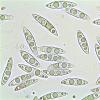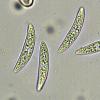
16-12-2010 00:02
 Pérez del Amo Carlos Manuel
Pérez del Amo Carlos Manuel
Pongo datos de este Ascocoryne que encontramos hac

14-12-2010 22:43
 Pérez del Amo Carlos Manuel
Pérez del Amo Carlos Manuel
Hola amigos; Nos gustaría poder confirmar esta

06-12-2010 19:06
 Yatsiuk Iryna
Yatsiuk Iryna
Good evening, This one was collected on the dead
Ascocoryne cylichnium var cylichnium
Pérez del Amo Carlos Manuel,
16-12-2010 00:02
 Pongo datos de este Ascocoryne que encontramos hace unos días sobre madera de Pinus nigra.
Pongo datos de este Ascocoryne que encontramos hace unos días sobre madera de Pinus nigra.Hemos seguido las claves de Baral y llegamos a A.cylichnium var cylichnium
Hans-Otto Baral,
16-12-2010 11:41

Re:Ascocoryne cylichnium var cylichnium
Dear Carlos
Yes, it is typical A. cylichnium. Multiseptate overmature spores forming subglobose free conidia and crystals, and croziers are typical. The best character is only seen on a few of your images: vital spores are consistently multiguttulate, contrary to sarcoides and inflata.
you don't have it fresh?
Zotto
Yes, it is typical A. cylichnium. Multiseptate overmature spores forming subglobose free conidia and crystals, and croziers are typical. The best character is only seen on a few of your images: vital spores are consistently multiguttulate, contrary to sarcoides and inflata.
you don't have it fresh?
Zotto
Pérez del Amo Carlos Manuel,
16-12-2010 19:08

Re:Ascocoryne cylichnium var cylichnium
Hola y gracias por la ayuda Zotto
Ya no disponemos de material fresco, pero si de material deshidratado aunque no es muy abundante.
La fotos de microscopía si están hechas con material fresco.
Carlos
Ya no disponemos de material fresco, pero si de material deshidratado aunque no es muy abundante.
La fotos de microscopía si están hechas con material fresco.
Carlos
Hans-Otto Baral,
16-12-2010 21:33

Re:Ascocoryne cylichnium var cylichnium
Hi Carlos
if you made the micros from fresh material you did not treat it well. :-/ The spore contents are strongly influenced by chemicals or whatever. Did you use pure water?
Zotto
if you made the micros from fresh material you did not treat it well. :-/ The spore contents are strongly influenced by chemicals or whatever. Did you use pure water?
Zotto
Pérez del Amo Carlos Manuel,
16-12-2010 23:53
Hans-Otto Baral,
17-12-2010 10:16

Re:Ascocoryne cylichnium var cylichnium
That looks nice but does not represent the intact case. It totally obscures the difference to A. sarcoides (in Sarcoscypha you will have the same effect that the species cannot be distinguished). To study the mature living state you need living asci, and inside them you will see the multiguttulate non-septate spores. As soon as the spores get septa they are overmature. That you have large drops inside might come from the reagent, I do not known.
Zotto
Zotto
Hans-Otto Baral,
17-12-2010 20:11

Re:Ascocoryne cylichnium var cylichnium
Wuff!
From which part of Spain?
Zotto
From which part of Spain?
Zotto
Pérez del Amo Carlos Manuel,
17-12-2010 20:15

Re:Ascocoryne cylichnium var cylichnium
Nalda
La Rioja
España
La Rioja
España


 13717.pdf
13717.pdf
